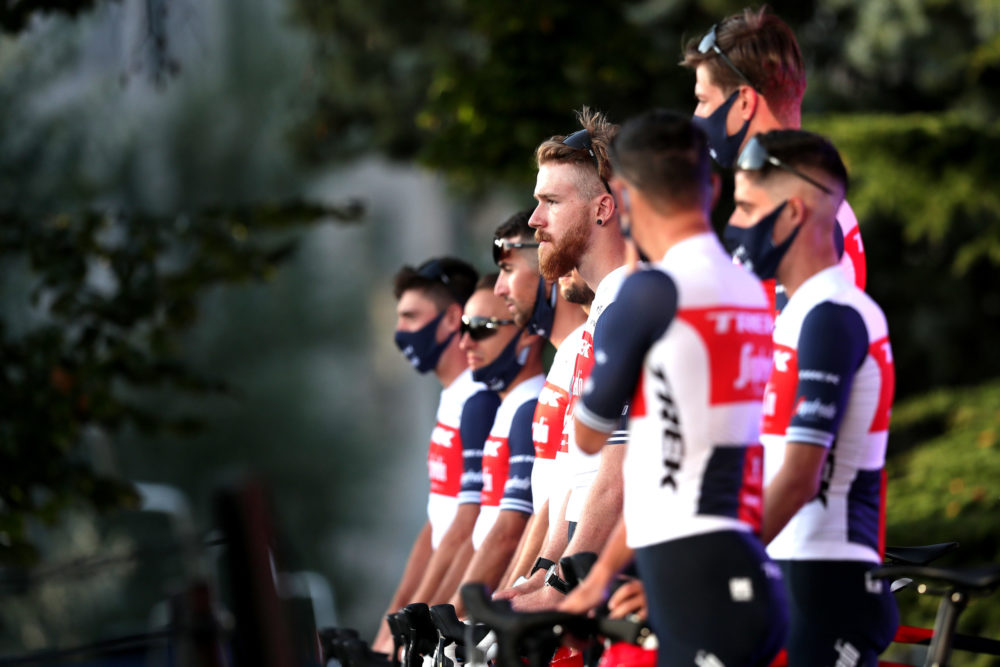Trek-Segafredo performance manager Josu Larrazabal offers his view on a Grand Tour of novelties and great opportunities
Spain in August shouts sea, sun, beaches and vacations. But it’s absolutely woe to think its national Grand Tour, La Vuelta, is a prelude to the riders’ holidays. Far from it. The Vuelta is a race that has left a significant mark in the history of cycling and, for a variety of reasons, has been a race of novelties and great opportunities.
Spaniard Josu Larrazabal has followed the race as a fan, as a Team Director, and finally as a Performance Manager. For many years, Larrazabal studied and prepared for La Vuelta, scrutinizing its details. In his words below, Josu helps us grasp its unique aspects, some that are undervalued when we talk about the final Grand Tour of the season.

BURGOS, SPAIN - AUGUST 14: Giulio Ciccone of Italy and Team Trek - Segafredo competes during the 76th Tour of Spain 2021, Stage 1 a 7,1km individual time trial from Burgos - Catedral de Santa María to Burgos / @lavuelta / #LaVuelta21 / #CapitalMundialdelCiclismo / #catedral2021 / on August 14, 2021 in Burgos, Spain. (Photo by Gonzalo Arroyo Moreno/Getty Images)
Distinctive parcours
“First, we have to give to Vuelta its merit, that of having been the first Grand Tour to anticipate the times and significantly modify the standard and traditional structure of the great stage races. When looking at the route, the so-called transitional stages are fewer and fewer, and the fast finishes often have details that make them less predictable.
“The organizers were the first to shorten the length of the stages, an added value in my opinion. They were also the first to launch themselves into the discovery of ever steeper, almost extreme finishes, sometimes, in a few editions, even too many.
“At the end, they brought forward the race period by two weeks in August, which allows the race to gain visibility thanks to many people on vacation. I believe this was a successful choice. And the start lists, always prestigious and international, are proof of this.
Opportunities await
“Besides the technical differences, the Vuelta has increasingly become the Grand Tour of big chances. The fact that it is the last one, in temporal order, makes it an opportunity for revenge and relaunching for the riders who have not achieved the expected results in the previous months. And for some, it can save an entire season. The most interesting and intriguing chances, however, are offered to young and rising riders.
“Many teams bring their budding talents to let them race the first Grand Tour of their careers, like Pogacar or, even earlier, Sagan. Others, to test them for the first time as leaders, as it was for Vincenzo Nibali, Chris Froome, and as it will be for Giulio Ciccone this year.
“The Vuelta presents the ideal conditions as a perfect stepping stone, also for its lower stress level. Let’s be clear; we’re still talking about a Grand Tour, with all the physical and mental stress it brings with it. But, for its moment in the season, there is not a climate of exasperated competitiveness like at the first event, the Giro, and especially at the Tour. I think it’s the best ground for a young person to discover the beauty and toughness of a three-week race.

BURGOS, SPAIN - AUGUST 12: Quinn Simmons of United States and Team Trek - Segafredo during the 76th Tour of Spain 2021 - Team Presentation / @lavuelta / #LaVuelta21 / #CapitalMundialdelCiclismo / #catedral2021 / on August 12, 2021 in Burgos, Spain. (Photo by Gonzalo Arroyo Moreno/Getty Images)
A tricky approach
“A rider who hunts stages with an eye on the world championships a few weeks later can consider the Vuelta as a step of growth, approaching it in a softer way. But for those who want to do well in the GC, a more systematic approach is required. For obvious reasons, it is very difficult for a GC rider to face the season aiming at the Vuelta as the first goal – much too risky.
“Racing it after the Tour, on the other hand, presents many, perhaps too many, unknowns: four weeks separate the race, not enough to ensure the best recovery and minimum preparation. It’s certainly not impossible to do well in France and Spain, but you really have to do the race step by step to understand how your body reacts.
“The best approach to get to a major peak of condition at the Vuelta, in my opinion, is to combine Giro and Vuelta, as we chose to do with Ciccone. This allows a major effort in May, followed by a break and progression in the following weeks. So, you can do measured and balanced programming, what we set out to do. Now, it’s time to put word to the street.”










































